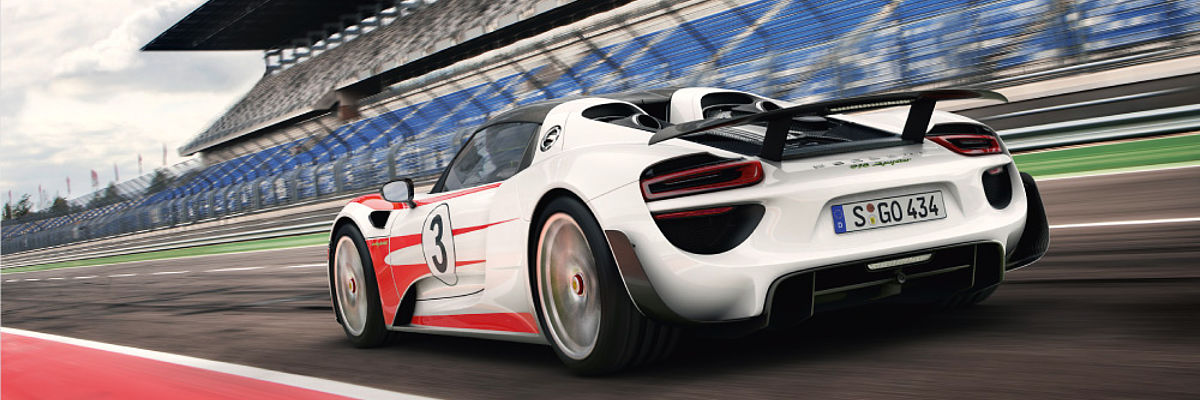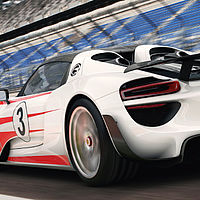Tyres are often an underestimated component in vehicle design: they represent the only contact with the road, have considerable influence on the safety and stability of the vehicle and determine the driving experience to a significant extent. Just as complex are the requirements in relation to tyre development – especially in the sports car sector. The HF MIXING TOGETHER editorial team wanted to know more details and set off to meet a representative from the sports car manufacturer par excellence.
We have an appointment with Michael Haupt, head of strategic tyre development at Porsche. When the name Porsche is mentioned, you generally think of Zuffenhausen. Haupt and his team, however, are based in the development centre in nearby Weissach, whose size impresses us as soon as we arrive: there are a number of multi-storey buildings, an in-house test track and several large parking spaces on this patch of green land. Michael Haupt has been working at Porsche for 17 years and is currently responsible for strategic tyre development. When he first came to Porsche, it was a completely different company:
"There was only the 911 back then; the Boxster was still in the development stage."
Tyre development was also less complex.
"We now develop tyres for all models: the 911, Boxster, Cayenne, Panamera, Macan – which has recently been unveiled to the general public – and occasionally for the GT vehicles 911 GT3 and 911 GT2, as well as for the plug-in hybrid 918 Spyder high-performance sports car. For the latter, we work in collaboration with the sports car division. Only the slick tyres for racing sport vehicles are developed by the motor sport division."
A development time of 48 to 60 months for one tyre
What specific form does tyre development take at Porsche?
"On new models, we develop the tyres from the vehicle's concept phase until it is ready to go into production. Since the wheels and tyres significantly define the look and design of a car, they are always looked at right at the beginning of the vehicles development. Due to the fact that we do not produce any tyres ourselves, or engineer them in detail, we tell the tyre manufacturer how the tyres should be composed so that it is specially tailored to the vehicles. To this end, we get together with all the major tyre manufacturers at a very early stage and consult with each other using all the basic data. At this stage, the CAD program has already created the so-called package models, which show how the vehicle will look. We know the weight, top speed and axle data – all essential parameters for designing tyres and defining the air pressure. As such, the tyre is initially evaluated virtually without any actual tests taking place. Once the package has been approved, the overall design of the vehicle is fixed. We then draw up the specification documents with all the criteria. This may include aspects such as reduced rolling resistance and faster lap times."
It takes between 48 and 60 months to develop one tyre – depending on whether it is a model facelift or a completely new development. The core development, actually testing the vehicle, takes two years.
The core development work
The actual development phase begins when prototype vehicles are available.
"We then conduct tests together with the tyre manufacturers on different tracks. We do these joint tests to ensure that the same conditions prevail for every tyre – in other words, we make sure they are tested at the same time, in the same place, with the same vehicle, on the same track."
The in-house test track in Weissach, however, is not suitable for testing tyres. It is too small and the weather conditions are not ideal.
"The tests are often conducted in southern Europe. The sun shines there, so we have optimal conditions for testing how the tyres handle in dry conditions and when changing lanes,"
says Haupt. The tyres on the 911 and Boxster sports cars are tested on the Northern Loop of the Nürburgring and in Nardò, the worlds fastest test track owned by Porsche Engineering.
"Both tracks are challenging and make high demands on the tyres."
A tyre must meet 33 testing criteria
At top speeds, it is tested whether the tyres give the vehicles sufficient stability, how they handle when driving in wet conditions and braking in dry conditions, how they affect the comfort of the ride, etc. Haupt and his team work together with the tyre industry to go through a total of 33 different testing criteria. The test drivers are given an evaluation form on which they can give each criterion a mark between one and ten.
"A mark of ten is outstanding and only very seldom given. Eight or nine is the level needed for approval and a mark of four or five is not acceptable. In such cases, the design needs to be reworked."
The tests are carried out on every tyre dimension, each of which has its own specification document with certain requirements.
During the European summer, winter tyres are tested in New Zealand; the summer tyres are generally tested in Europe. Porsche conducts the wet handling tests on test tracks belonging to manufacturers in the tyre industry. The logistical work involved is immense: several lorry loads of 200 or more tyres and five or six test vehicles have to be planned and moved around.
"We don't just test on racetracks, however. It goes without saying that our cars also have to be tested on A roads and motorways. This is done in the context of so-called endurance tests. If all the criteria have been met after the tests, Porsche grants its approval to the tyre manufacturer. The tyre is then given an N label, the Porsche seal of approval for tyres."
"Once the tyre goes into series production, new problems can suddenly arise for the manufacturer, because it is one thing producing 20 prototypes, but quite another manufacturing 2,000 tyres,"
says Haupt, briefly outlining the problems associated with series production.
Performance versus comfort
The extended model range has changed Porsches approach to tyre development:
"We come from a pure sports car segment,"
explains Haupt.
"Accordingly, our aim was always to be the best in class when it came to performance, braking in dry conditions and lap times. It is important to us that we hold the record for the fastest lap time on the Northern Loop of the Nürburgring. This is currently six minutes and 57 seconds in the 918 Spyder. In other words, we also have to be extremely performance-oriented when developing tyres. However, as a result of models like the Cayenne, the Panamera and soon also the Macan, we are faced with the challenge of improving the balance between comfort and performance. That goes for many components on the car and also for the tyres."
A shift in the markets has also contributed to the complexity of Haupts remit: in China, for instance, Porsche customers tend to drive their vehicles more frequently in urban regions where there is often stop-and-go traffic.
"We have to pay greater attention to comfort and exterior noise here."
Other challenges are issues such as reducing CO2 emissions and improving rolling resistance, areas on which Porsche has worked hard in recent years with the tyre industry.
"In terms of tyre development, on the one hand, we must achieve the best lap times and good braking distances, aspects which call for a compound that provides excellent grip. This is associated with a high degree of hysteresis, however, which is manifested in poorer rolling resistance. On the other hand, we have to develop tyres whose compound reduces rolling resistance and thus CO2 emissions."
In this regard, Haupt and his team are constantly calling for the tyre manufacturers to use new technologies and materials, because the tyre has a very big influence on reducing CO2 emissions.
"There will be a continued focus on cutting CO2 emissions in future, because such aspects are crucial in terms of the social acceptance of our vehicles,"
says Haupt.
Its all about the compound
Since the tread compound is responsible for 50 to 60 per cent of the rolling resistance, a tyre manufacturer must constantly break new ground when developing compounds.
"There is a tendency towards using ever more complex compounds as well as the dual tread compound, which involves either distributing two compounds horizontally across the tread – in other words, on the inner and outer area of the tyre – or vertically using a so-called cap-and-base compound. Different compound properties in conjunction with complex production technology mean that the manufacture of tyres is becoming an evermore complex operation."
Furthermore, Haupt sees a trend towards using organic raw materials in order to ensure greater sustainability in the development process.
The challenges of the future
Besides the increasing demands already mentioned, Haupt expects one thing in particular in the future: further legal provisions.
"It won't be long before the issue of tyre labelling explodes. For every tyre, in a similar way to refrigerators, we are compelled to state the fuel efficiency class, wet grip class and rolling noise class, together with the corresponding values. Unfortunately, these labels look different from one country to the next, which presents us with a demanding task."
External rolling noise reduction will soon also be specified by the EU. That is a particular challenge for a sports car manufacturer with wide tyres.
"At Porsche, this means that we will have to reduce the noise of the tyres by three or four decibels over the coming years – a huge challenge which once again necessitates technological changes in the tyre industry, because the tread and the compounds will have to be modified. As a result, I am also convinced that, in terms of performance, there will no longer be any scope for developing further major enhancements in future."
It is clear to us that the challenges faced by Haupt and his team are diverse. The sphere of activity in which they are operating is subject to constant tension, so his following statement comes as no real surprise:
"It all involves a great deal of work. Yet the real art lies in bringing everyone together, both internally at Porsche, e.g. to coordinate the control systems and chassis, and among the Porsche employees and tyre manufacturers. There is increasing complexity; people have to communicate with one another – and that takes place at an incredible speed these days."
As we take our leave, Michael Haupt gives us a piece of good news to take back to the HF MIXING GROUP:
I do not envisage that we will see a rubber-free tyre within the next six to eight years.
We wish to thank Michael Haupt for talking to us and giving us an interesting insight into his work!



